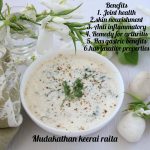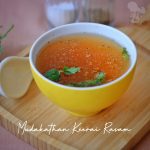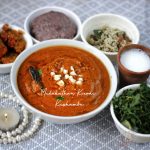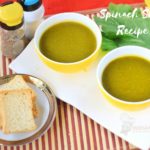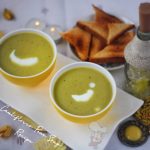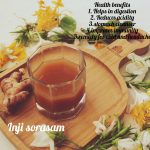"Harness the power of nature with this age-old recipe for Mudakathan keerai soup, blending the goodness of fresh leaves with aromatic spices for a truly authentic and nourishing culinary experience. Indulge in the vibrant flavors of Mudakathan keerai soup, a cherished recipe that combines the richness of tradition with the healthful properties of this remarkable leafy green."
Multifarious Topics Covered In The Recipe:
1. Mudakathan Keerai Soup
2. An Insight Into The " Natural Food" Of Tamil Nadu
3. The Primitive History Of " Leafy Green Varieties" Of Tamil Nadu
4. The Interesting Story Of Mudakathan Keerai- A leafy Green Worth Exploring
5. Needed Ingredients To Make Mudakathan Keerai Soup
6. Step wise Directions To Make Authentic Mudakathan Keerai Soup
7. Why This Recipe Works
8. Faqs
9. Mudakathan Keerai Soup In A Nutshell
10. The Healing Properties Of Mudakathan Keerai Soup
11. The Role Of Mudakathan Keerai In Ancient Indian Culinary Journey
12. Some Common Attributes Of Mudakathan Keerai Soup
13. Needed Ingredients To Make Mudakathan Keerai Soup
14. Step Wise Directions To Make Mudakathan keerai Soup
15. Nutritional Value
16. The Takeaway
"The comforting aroma of Mudakathan keerai soup fills the air, as its vibrant green hues beckon with promises of nourishment. With each spoonful, one can taste the essence of nature's bounty, as this humble soup delights the palate and nourishes the body. Mudakathan keerai, a treasure trove of vitamins and minerals, bestows its unique flavors upon us, reminding us of the power of simple ingredients and the joy of savoring a wholesome bowl of goodness."
An Insight Into The "Natural Food" Of Tamil Nadu:
"In the heartland of Tamil Nadu, a land blessed with rich agricultural heritage, lies a culinary tradition deeply rooted in the principles of Iyarkai Unavu, the art of natural and holistic eating. Tamil Nadu's cuisine is a celebration of the bountiful gifts of nature, where every ingredient is carefully selected, prepared, and combined to create a harmonious symphony of flavors, textures, and nourishment.
From the vibrant array of locally grown spices to the diverse range of indigenous grains, vegetables, and herbs, Tamil Nadu's Iyarkai Unavu embodies a profound connection with the land, embracing the philosophy that food is not merely sustenance but a source of healing, well-being, and culinary delight. Let us embark on a culinary journey through the verdant fields and bustling markets of Tamil Nadu, where the essence of nature's offerings flourishes on every plate, creating a tapestry of tastes that truly nourish the body, mind, and soul."
The Primitive History Of " Leafy Green Varieties" Of Tamil Nadu:
The green varieties of keerai (leafy greens) in Tamil Nadu have a rich and primitive history deeply intertwined with the region's agricultural practices and cultural heritage. These green treasures have been a vital part of Tamil Nadu's traditional cuisine for centuries, offering a plethora of health benefits and culinary delights.
In the primitive history of Tamil Nadu, communities relied heavily on the indigenous knowledge of local plants and their medicinal properties. The ancient Tamil literature, such as Sangam literature, mentions the usage of various types of keerai as food and medicine. These writings highlight the deep understanding and reverence for the healing and nutritional properties of these leafy greens.
Tamil Nadu's tropical climate and fertile lands provide an ideal environment for the cultivation of a wide range of keerai varieties. From the robust and slightly bitter amaranth leaves to the delicate and aromatic agathi keerai (sesbania grandiflora), the land of Tamil Nadu boasts a diverse array of green leafy vegetables.
The people of Tamil Nadu have passed down their knowledge of these greens from generation to generation, preserving and celebrating the rich cultural heritage associated with them. In rural communities, gathering wild greens from the fields and forests has been a customary practice, emphasizing the symbiotic relationship between humans and nature.
The popularity of keerai in Tamil Nadu's cuisine can be attributed to its remarkable nutritional value. These greens are packed with essential vitamins, minerals, fiber, and antioxidants, contributing to good health and well-being. They are known for their cooling properties and are often incorporated into meals to balance the flavors and aid digestion.
Over time, these traditional greens have found their way into a wide range of dishes, including keerai masiyal (mashed greens), keerai poriyal (stir-fried greens), keerai kootu (greens and lentil stew), and keerai soup, among others. The flavors and textures of these greens add depth and vibrancy to the culinary tapestry of Tamil Nadu, making them an integral part of the region's gastronomic heritage.
Today, as the world embraces the importance of sustainable and locally sourced food, the green varieties of keerai in Tamil Nadu continue to gain recognition for their nutritional value, environmental friendliness, and connection to the land. They serve as a reminder of the wisdom and ingenuity of our ancestors, who understood the profound benefits of embracing nature's gifts in their purest form.
In essence, the primitive history of green varieties of keerai in Tamil Nadu is a testament to the profound relationship between the people, the land, and the nourishing power of these leafy greens. They stand as a living testament to the harmonious coexistence of culinary heritage, cultural practices, and a deep-rooted respect for nature's abundance.
The Interesting Story Of Mudakathan Keerai:- A Leafy Green Worth Exploring:
Mudakathan keerai, scientifically known as Cardiospermum halicacabum, has a fascinating origin and history that spans centuries. This leafy green is native to tropical and subtropical regions, including parts of India, Sri Lanka, and Southeast Asia. Let's explore the origin and historical significance of Mudakathan keerai:
Origin:
Mudakathan keerai finds its roots in the ancient traditional systems of medicine, particularly Ayurveda and Siddha, where it has been revered for its medicinal properties. It grows abundantly in the wild and is also cultivated in home gardens and farms in Tamil Nadu and other regions with a similar climate.
Historical Significance:
Mudakathan keerai has a long history of traditional use in Tamil Nadu and other parts of South India. It has been mentioned in ancient Tamil literature, including the Siddha texts, which date back thousands of years. These texts describe the plant's therapeutic applications and highlight its importance in traditional medicine.
Traditional Uses:
In traditional medicine, Mudakathan keerai is highly regarded for its anti-inflammatory, analgesic, and diuretic properties. It has been used to treat various ailments, including arthritis, joint pain, skin disorders, digestive issues, and urinary problems. The leaves, stems, and seeds of the plant are used in different preparations, such as herbal pastes, concoctions, and oils.
Culinary Uses:
Apart from its medicinal uses, Mudakathan keerai also finds its way into the culinary world. In Tamil Nadu, it is commonly used in the preparation of soups, rasam (a tangy South Indian soup), and traditional dishes like keerai masiyal (mashed greens) and keerai kootu (greens and lentil stew). Its slightly bitter taste and unique flavor profile add depth to these dishes.
Modern Recognition:
In recent years, Mudakathan keerai has gained recognition beyond traditional medicine and local cuisine. Its nutritional value, rich phytochemical content, and potential health benefits have attracted the attention of researchers and health enthusiasts. The plant is being studied for its antioxidant, anti-inflammatory, and anti-cancer properties, among other potential health-promoting effects.
Today, Mudakathan keerai is sought after by those who appreciate its traditional uses, medicinal properties, and unique taste. It continues to be a part of Tamil Nadu's culinary heritage, preserving the wisdom of generations and showcasing the rich cultural significance of native plants.
In conclusion, Mudakathan keerai's origin and history are deeply rooted in traditional medicine and culinary practices in Tamil Nadu. Its presence in ancient texts, traditional remedies, and regional cuisines highlights its significance in the cultural fabric of the region. As the world increasingly recognizes the value of indigenous plants and their potential benefits, Mudakathan keerai stands as a testament to the wisdom of ancient knowledge and the enduring relevance of natural remedies.
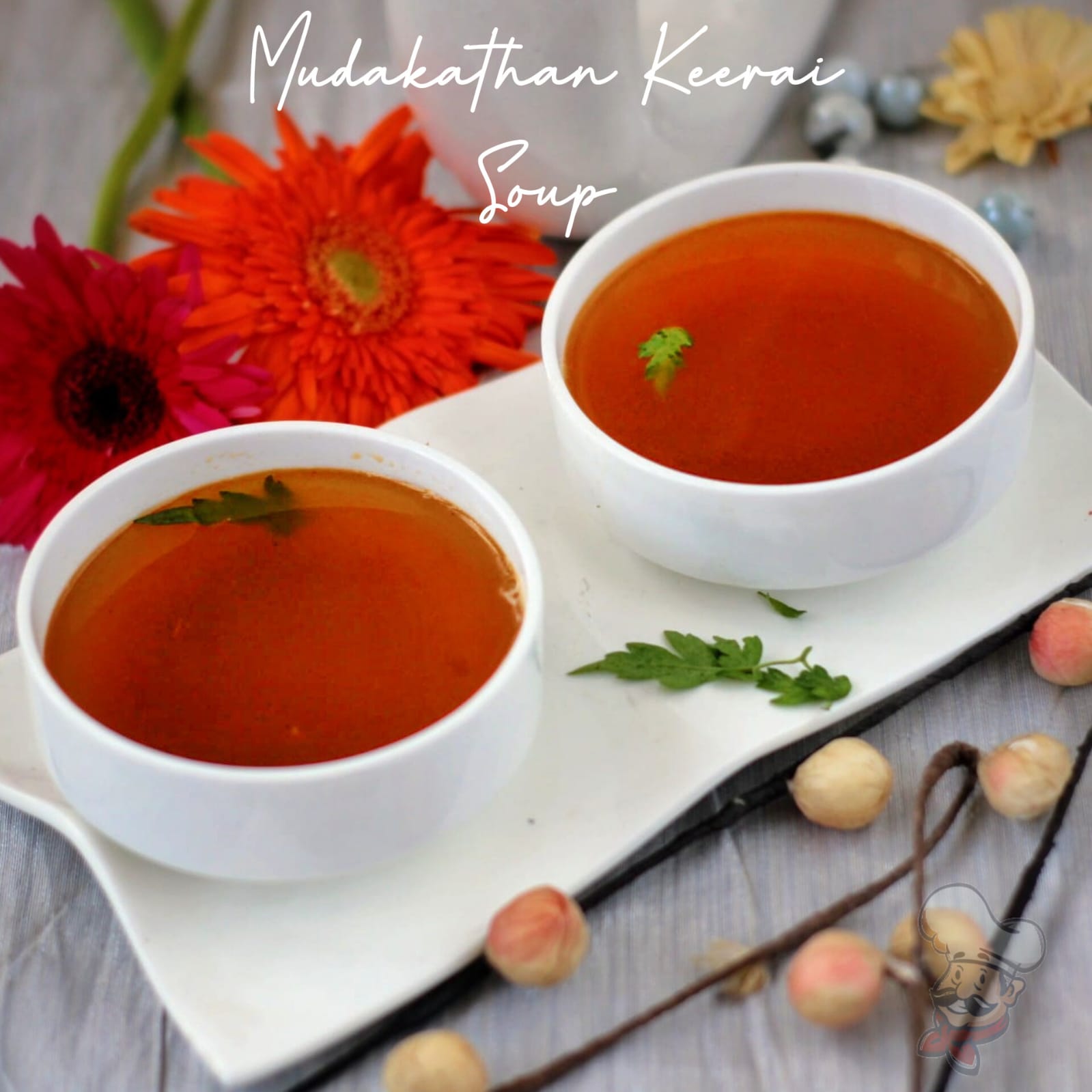
Needed Ingredients To Make Mudakathan Keerai Soup:
Step wise Directions To Make Authentic Mudakathan Keerai Soup:
Clean the Mudakathan keerai leaves thoroughly, remove any tough stems, and wash them in cold water. Chop the leaves finely and set them aside.
Take a mortar and pestle and wipe it with a clean cloth. Add a teaspoon of black peppercorns and cumin seeds each and crush them coarsely. Then drop in the measured quantities of shallots and garlic one after another and pound them well. Finally, drop in a piece of fresh raw ginger and thump altogether. Take out the coarse spice mixture and place it in a small cup aside.
Heat a saucepan and pour in two cups of water and when it starts to boil, strew in the mudakathan keerai and follow it up with some chopped tomatoes.
Add a pinch of rock salt and asafoetida and lower the flame.
After five minutes, plop in the crushed spice mixture with a nice stir. let it continue to boil in low flame for a few minutes.
When the leaves and well cooked and done, turn off the flame and gently take the saucepan from the stove.
Filter the soup using a strainer or a tea filter to get a clear mudakathan soup.
Add some salt and pepper and serve instantly while it is still hot.
Why This Recipe Works:
Choose fresh Mudakathan keerai: Select fresh and vibrant Mudakathan keerai leaves for the best flavor and nutritional value. Ensure that the leaves are free from wilting or discoloration.
Thoroughly clean the leaves: Before using Mudakathan keerai, clean the leaves thoroughly to remove any dirt or impurities. Rinse them under cold water and gently pat them dry using a kitchen towel.
Remove tough stems: Trim any tough stems or thick veins from the Mudakathan keerai leaves. Focus on using the tender parts of the leaves for a smoother texture in the soup.
Balancing flavors: Mudakathan keerai has a slightly bitter taste. To balance the flavors, you can add ingredients like tomatoes, onions, garlic and spices. Adjust the seasoning according to your preference.
Cook the keerai adequately: When adding the Mudakathan keerai leaves to the soup, allow them to wilt and cook properly. This ensures that the leaves become tender and blend well in the soup.
Season to taste: Taste the soup before serving and adjust the seasoning as needed. You can add salt, freshly ground black pepper, or a squeeze of lemon juice for an extra burst of flavor.
Garnish creatively: Consider garnishing your Mudakathan keerai soup with fresh herbs like coriander leaves or a few drops of ghee for added freshness and visual appeal.
Serve hot: Mudakathan keerai soup is best enjoyed hot. Serve it immediately after preparation for the optimal taste experience.
By following these tips, you can create a perfect Mudakathan keerai soup that showcases the flavors, nutrients, and culinary delight this leafy green has to offer. Enjoy your delicious and nourishing soup!
Faqs:
What is Mudakathan keerai?
Mudakathan keerai, also known as Balloon vine or Heart-leaf moon seed, is a leafy green that is native to tropical and subtropical regions, including parts of India and Southeast Asia. It is widely used in traditional medicine and culinary practices.
What are the health benefits of Mudakathan keerai soup?
Mudakathan keerai is known for its potential health benefits. It is rich in vitamins, minerals, and antioxidants, and has been traditionally used for its anti-inflammatory and diuretic properties. Consuming Mudakathan keerai soup may help support digestion, promote healthy skin, and provide a boost to the immune system.
How do I clean Mudakathan keerai for the soup?
To clean Mudakathan keerai, remove any tough stems or thick veins. Rinse the leaves thoroughly under cold water to remove dirt or impurities. Gently pat them dry using a kitchen towel before using in the soup.
Can I use frozen Mudakathan keerai for the soup?
Fresh Mudakathan keerai is preferable for the soup, as it retains its flavors and nutrients. However, if fresh Mudakathan keerai is not available, you can use frozen Mudakathan keerai as an alternative. Just make sure to thaw it before adding it to the soup.
Can I store Mudakathan keerai soup for later consumption?
Mudakathan keerai soup is best enjoyed fresh, but if you have leftovers, you can store them in an airtight container in the refrigerator for up to 2-3 days. Reheat the soup gently on the stove top before serving.
Can I add other vegetables or ingredients to the Mudakathan keerai soup?
Absolutely! You can customize your Mudakathan keerai soup by adding other vegetables such as carrots, potatoes, or bell peppers. You can also incorporate spices like cumin, coriander, or chili flakes to enhance the flavor profile according to your preference.
Mudakathan Keerai Soup In A Nutshell:
Nature: Mudakathan keerai soup is a nourishing and comforting dish made from the leaves of the Mudakathan keerai plant. It embodies the natural essence of the leafy green and is often prepared with a focus on its health benefits and culinary appeal.
Color: The color of Mudakathan keerai soup can vary depending on the ingredients used, but it typically has a vibrant green hue. The intensity of the color may depend on the amount of keerai used and the cooking time.
Texture: When properly blended, Mudakathan keerai soup has a smooth and velvety texture. It should be free from any fibrous or coarse bits, allowing the soup to glide easily on the palate.
Consistency: The consistency of Mudakathan keerai soup can be adjusted to personal preference. It is commonly prepared with a medium thickness, resembling a light and creamy soup. However, you can adjust the amount of water or broth to achieve your desired consistency.
Flavor: Mudakathan keerai has a slightly bitter taste, which adds a unique flavor profile to the soup. The bitterness is balanced with other ingredients such as onions, tomatoes, and spices. The overall flavor can be described as earthy, slightly bitter, and subtly herbaceous.
Smell: When cooked, Mudakathan keerai soup emits a pleasant aroma that combines the natural fragrance of the leafy greens with the aromatic spices and ingredients used. The smell can be described as fresh, green, and inviting.
Taste: The taste of Mudakathan keerai soup is a delightful blend of flavors. It has a mild bitterness from the keerai, complemented by the tanginess of tomatoes and the subtle sweetness of onions. The taste may vary depending on the specific recipe and personal preferences.
In summary, Mudakathan keerai soup embodies the natural essence of the leafy green, with its vibrant green color, smooth texture, balanced flavor, and pleasant aroma. It offers a unique taste experience that combines the inherent bitterness of the keerai with the harmonious interplay of other ingredients.
The Healing Properties Of Mudakathan Keerai Soup:
Mudakathan keerai soup is believed to possess several healing properties, which can be attributed to the nutritional composition and potential health benefits of Mudakathan keerai itself. Here are some healing properties associated with Mudakathan keerai soup:
Anti-inflammatory properties: Mudakathan keerai contains bio active compounds that exhibit anti-inflammatory effects. Consuming Mudakathan keerai soup may help reduce inflammation in the body, potentially benefiting conditions such as arthritis, joint pain, and inflammatory disorders.
Antioxidant effects: Mudakathan keerai is rich in antioxidants, including flavonoids and phenolic compounds. These antioxidants help combat oxidative stress caused by free radicals in the body, reducing cellular damage and supporting overall health.
Digestive support: Mudakathan keerai has been traditionally used for digestive health. It is believed to aid in digestion, relieve constipation, and promote healthy bowel movements. The fiber content in Mudakathan keerai may contribute to improved digestive function.
Diuretic properties: Mudakathan keerai is considered to have diuretic properties, meaning it may help increase urine production and promote the elimination of waste products from the body. This can aid in detoxification and support urinary tract health.
Skin benefits: The antioxidants and anti-inflammatory compounds present in Mudakathan keerai may contribute to healthy skin. Regular consumption of Mudakathan keerai soup, along with a balanced diet, may help maintain skin health and reduce the risk of certain skin conditions.
Nutritional value: Mudakathan keerai is a good source of essential vitamins, minerals, and dietary fiber. Consuming Mudakathan keerai soup can provide a range of nutrients, including vitamin A, vitamin C, iron, calcium, and potassium, which are vital for maintaining overall health and well-being.
The Role Of Mudakathan Keerai In Ancient Indian Culinary Journey:
Traditional Ayurvedic and Siddha Medicine: Mudakathan keerai has a long history of use in Ayurvedic and Siddha systems of medicine in India. It has been recognized for its medicinal properties, including its anti-inflammatory, diuretic, and digestive benefits. Ancient healers and practitioners often incorporated Mudakathan keerai into medicinal preparations to promote overall health and well-being.
Culinary Diversity: Mudakathan keerai has been embraced in various regional cuisines across India. Different states and communities have their unique ways of incorporating Mudakathan keerai into their traditional dishes, highlighting the versatility of this leafy green.
Leafy Green Delicacy: Mudakathan keerai is often used as a key ingredient in curries, stir-fries, soups, and stews. Its slightly bitter taste adds depth and complexity to dishes, enhancing the overall flavor profile. It has been traditionally used in combination with other vegetables, lentils, or spices to create delicious and nutritious meals.
Cultural Significance: Mudakathan keerai holds cultural significance in many Indian communities. It is often consumed during specific festivals or religious observances, symbolizing health, abundance, and well-being. Its inclusion in traditional meals is a reflection of the deep-rooted connection between food, culture, and spirituality in India.
.Nutritional Value: Mudakathan keerai is known for its nutritional richness. It is packed with vitamins, minerals, dietary fiber, and antioxidants. Ancient Indian culinary traditions recognized the importance of incorporating nutrient-dense ingredients like Mudakathan keerai to support a balanced and healthy diet.
Sustainability and Local Sourcing: Mudakathan keerai is abundant in India, and its availability in local ecosystems has contributed to its widespread usage. Ancient culinary practices often emphasized the use of locally sourced and sustainable ingredients, and Mudakathan keerai perfectly fits this ethos.
In summary, Mudakathan keerai has played a significant role in the ancient Indian culinary journey. Its unique flavor, nutritional benefits, and traditional medicinal uses have made it a valuable ingredient in various regional cuisines. Mudakathan keerai's inclusion in traditional dishes reflects the holistic approach to food and health in ancient Indian cultures.
Some Common Attributes Of Mudakathan Keerai Soup:
Nutritious: Mudakathan keerai soup is packed with essential nutrients, including vitamins, minerals, and dietary fiber. It is a healthy addition to a balanced diet, providing nourishment and supporting overall well-being.
Vibrant Color: Mudakathan keerai soup typically has a vibrant green color. This visually appealing hue adds to the aesthetic appeal of the soup, making it visually enticing and appetizing.
Smooth Texture: When properly prepared and blended, Mudakathan keerai soup has a smooth and velvety texture. It should be free from any coarse or fibrous bits, ensuring a pleasant and enjoyable eating experience.
Balanced Flavor: Mudakathan keerai soup offers a balanced flavor profile. The slightly bitter taste of Mudakathan keerai is complemented by the flavors of other ingredients such as onions, tomatoes, and spices. The overall flavor is a harmonious blend of earthy, slightly bitter, and subtle herbaceous notes.
Aromatic: Mudakathan keerai soup emits a pleasant aroma when cooked. The natural fragrance of the leafy greens, combined with the aromatic spices and ingredients used in the soup, creates an inviting and aromatic experience.
Versatile: Mudakathan keerai soup can be customized to suit individual tastes and preferences. It serves as a versatile base that can be enhanced with various vegetables, herbs, spices, and seasonings to create different flavor profiles according to personal preference.Comforting and Nourishing: Mudakathan keerai soup is often described as a comforting and nourishing dish. It is a warm and wholesome option that provides a sense of satisfaction and nourishment, making it ideal for chilly days or when seeking a nutritious meal.
Healthy: Mudakathan keerai soup is believed to possess various health benefits due to the nutritional composition of Mudakathan keerai itself. It is often associated with anti-inflammatory, antioxidant, and digestive-supporting properties, making it a healthful choice.
- To conclude, Mudakathan keerai soup is a nutritious, visually appealing, and flavorful dish that offers a harmonious blend of taste, texture, and aroma. It can be enjoyed as a standalone meal or as a part of a larger Indian culinary experience.
The Takeaway:
"Age-old and steeped in tradition, Mudakathan keerai soup is a testament to the goodness and authenticity of ancient culinary practices. With its vibrant green color, smooth texture, and balanced flavors, it nourishes both body and soul. From its healing properties to its rich heritage, every sip of this soup is a celebration of the timeless wisdom and wholesome essence of Indian cuisine."
Ingredients
Directions
Clean the Mudakathan keerai leaves thoroughly, remove any tough stems, and wash them in cold water. Chop the leaves finely and set them aside.
Take a mortar and pestle and wipe it with a clean cloth. Add a teaspoon of black peppercorns and cumin seeds each and crush them coarsely. Then drop in the measured quantities of shallots and garlic one after another and pound them well. Finally, drop in a piece of fresh raw ginger and thump altogether. Take out the coarse spice mixture and place it in a small cup aside.
Heat a saucepan and pour in two cups of water and when it starts to boil, strew in the mudakathan keerai and follow it up with some chopped tomatoes.
Add a pinch of rock salt and asafoetida and lower the flame.
After five minutes, plop in the crushed spice mixture with a nice stir. let it continue to boil in low flame for a few minutes.
When the leaves and well cooked and done, turn off the flame and gently take the saucepan from the stove.
Filter the soup using a strainer or a tea filter to get a clear mudakathan soup.
Add some salt and pepper and serve instantly while it is still hot.

